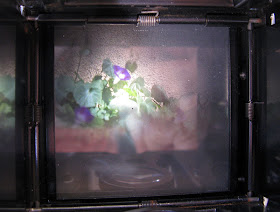
I put another roll of film through my No. 1-A Folding Pocket Kodak
Special after making some modifications to make it easier to use 120
rollfilm.
The easiest part of the conversion is the modification of the 116
take-up spool. I made a couple washers from the rubber backing material
off a mouse pad, cut them in half and glued them to the inside faces of
the spool end disks. The 1/8-inch thickness is just right to shield
the edges of the 120 film against the light.
For the supply-side, I made a film holder from a plastic Adox film can.
A hole in the bottom and another in the rubber disk holds everything in
place securely, and the film comes out through the slit down the side.
Besides being simple to implement, this solution didn't require any
irreversible modification to the camera.
The film rails need to be just an eighth-inch wider on each side to
properly mask and support the 120 width film. I used some black
mounting board. The first strip was made a bit wider so it would slide
under the existing frame rails and help support the new ones. On top of
that, I glued two more 1/8-inch-wide strips, and these were also glued
on the outer sides to the metal frame using hide glue. The mounting
board is tough stuff to cut, but using my mat cutter enabled me to make
the strips thin and straight.
One solution to frame spacing is to relocate the red window to the center of the camera back, enabling the use of the center row of numerals on the 120 backing paper; using every other number yields six non-overlapping frames per roll.
I was reluctant to drill a hole in my nice old Kodak folder to get the
proper frame spacing. However, I found that the existing red window in
the lower right corner of the back let me make use of the 6x4.5 framing
numerals to get five evenly spaced frames using every third number,
starting with number 3.
I'm not sure that I made any real improvement in image quality through
the conversion, but the camera is quite a bit easier to use. One
problem that cropped up was that the film edge is closer to the red
window, and I am presently getting quite a bit of light leakage onto
that side. I'll try painting out half of the window, and I'll also see
if some well-placed foam light seal helps.
So, still a bit of work to be done, but I only have an hour or two into
the project, and it turned out to be quite a bit easier than I had
anticipated.



















